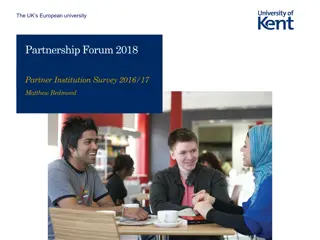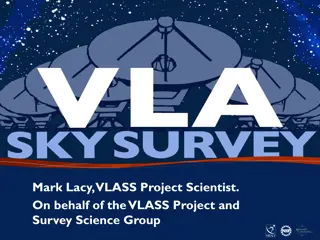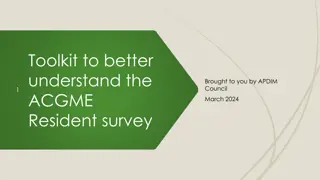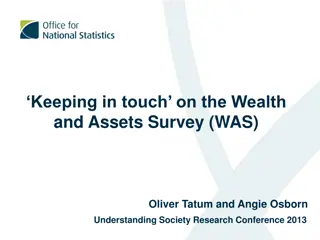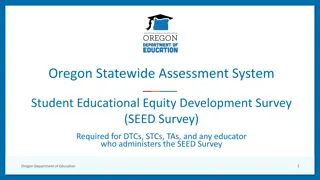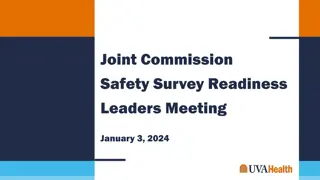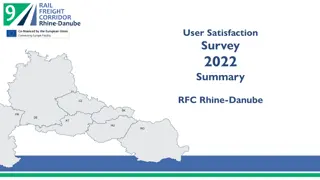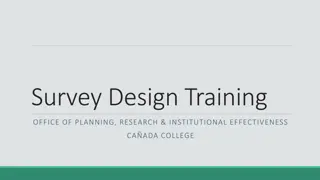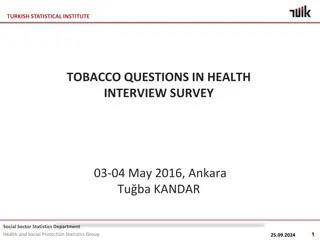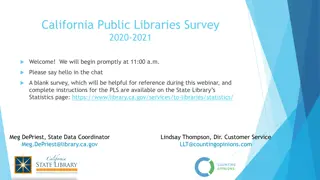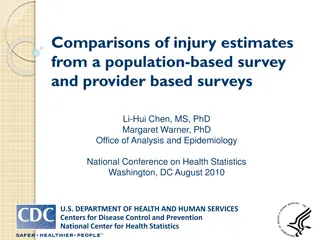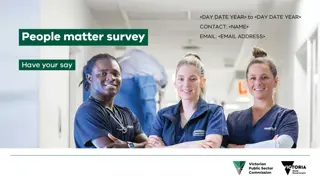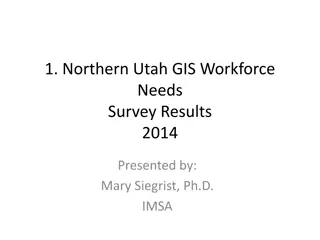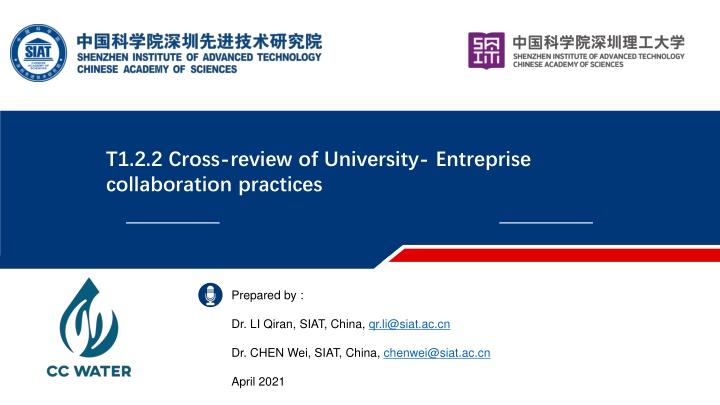
Cross-Review of University-Enterprise Collaboration Practices
This report presents a cross-review of university-enterprise collaboration practices prepared by Dr. LI Qiran and Dr. CHEN Wei from SIAT, China. It includes information on existing practices, strengths, weaknesses, and survey results from partner universities. The summary highlights discrepancies in responses, internship requirements for students, and partnership modalities.
Download Presentation

Please find below an Image/Link to download the presentation.
The content on the website is provided AS IS for your information and personal use only. It may not be sold, licensed, or shared on other websites without obtaining consent from the author. If you encounter any issues during the download, it is possible that the publisher has removed the file from their server.
You are allowed to download the files provided on this website for personal or commercial use, subject to the condition that they are used lawfully. All files are the property of their respective owners.
The content on the website is provided AS IS for your information and personal use only. It may not be sold, licensed, or shared on other websites without obtaining consent from the author.
E N D
Presentation Transcript
T1.2.2 Cross-review of University- Entreprise collaboration practices Prepared by : Dr. LI Qiran, SIAT, China, qr.li@siat.ac.cn Dr. CHEN Wei, SIAT, China, chenwei@siat.ac.cn April 2021
1 Objective T1.2.2 Cross-review of university-enterprise collaboration practices. Partners will systematise and present information about practices of university-enterprise collaboration existing at their universities. This will include forms of collaborations, partnership modalities, ways to establish contacts with enterprises etc. The report will be prepared as set of annotated slides for presentation. Expected deliverable: Report on existing practices: strength and weaknesses Description: This report will contain information on practices of university-enterprise collaboration existing at partner universities presented as annotated slides. 3
1 Abbreviations: NMBU Norwegian University of Life Sciences UWM University of Warmia and Mazuryin Olsztyn UOP University of Peradeniya RULS RajarataUniversity ofSri Lanka SEULS South Eastern University of Sri Lanka MUST Mongolian university of science and technology NUM National University of Mongolia QUT Qingdao University of Technology SIAT Shenzhen Institute of Advanced Technology IMUFE Inner Mongolia University of Finance and Economics THOWL OWL University of Applied Sciences and Arts 4
2 Summary for the survey result : We have received 12 responses and University of Peradeniya from Sri Lanka has replied twice, the major discrepancy for these replies could be attributed to different master programs in the same university. However NUM and one of Up replies have not addressed on the last question about the project example. 6
2 Summary for the survey result : Q1, Is there any mandatory/recommended internship in industrial sector for your students enrolled in the current program -50% of the institutes has no such an internship requirement in the current program -25% of the institutes has the requirement for internship which is less than 3 months while the rest of institutes has the requirement for more than 3 month-internship 7
2 Summary for the survey result : Q2, If the students in your current program involved in one or two predefined internships, could you please describe briefly how does it work and what is the criteria to validate the module of internship ? -(16%) MUST and SIAT have mentioned that the students are generally involved in industrial application-oriented project -(25%)THOL, RUSL and QUT currently have no specified module for internship -About 60% of the institutes has a similar standard for the internship module : The subject must be related to the study program; An office at department or university level is taking responsibility to valid the internship module; The students should accomplish all the academic courses before entering the internship module 8
2 Summary for the survey result : Q3, In your current program, is there any offer for continuing education dedicated to employees from industry and / or public administration ? -75% of the institutes has the continuing education program while THOL, RUSL, NUM and UoP have not provided this possibility yet. 9
2 Summary for the survey result : Q4, If your program provides actually the opportunities for continuing education, could you describe it briefly here, especially for the following subjects : admission, duration and evaluation in comparison with formal higher education system. Among the 8 institutes/ programs providing the continuing education, the major findings are : -The admission is rather the same in comparison with the academic master program with a selective entrance examination -3 institutes can provide part-time programs while the other 3 can only provide full- time program currently. The other 2 institutions have not specified on this detail -The duration of these program can vary from weeks to 2.5 years while the full-time program is between one year to 2.5 years with 60 to 120 ECRS (or equivalence) 10
2 Summary for the survey result : Q5, Are there any lecturers from Industry and or Public administration who give lectures in your current program (multiple choices possible) -Almost all the institutes have lecturers from non-academic world (94%) -The lectures for scientific and technical courses/modules are prevailing to those in common knowledge module 11
2 Summary for the survey result : Q6, Are there any regular seminars / workshops in your current program, conducted by non-academical professionals ? If so, please indicate an approximated frequency of these events (situation before pandemic can be included here) -4 institutes/ have relatively frequent (more than once per semester) seminar conducted by professional from industry or public entities while 7 institutes/ program have only few (less than once per year or not applicable) similar events. 12
2 Summary for the survey result : Q7, Among the following types of projects, which of them summarizes better about your on- going and previous R&D projects with participation of enterprises. (multiple choices possible) -Public fundings are overwhelming for this moment 13
2 Summary for the survey result : Q8, In the framework of your current program, which percentage describes better the work load associated with projects and /or services related to industrial/public administration partners. -Half of the institutes has more than 10% work load in collaboration with non-academic partners 14
2 Q9, Project examples -THOL Research project together with a water utility and two industrial companies concerning Phosporus reuse from wastewater. Project is funded by a public donor organization. Target of the project is to investigate the possibilities of enhancing the P-content in digestor sludge to enable P-extraction technologies. Based on lab work and investigations a semi- technical scale plant is intended. Currently the lab investigations are finished and the operation of digester start in the next weeks. Industrial involvement is intended for the investigation into real scale. Furthermore a company with the knowledge on the technology of P-recovery from sludge by pyrolisis is a project partner. The water utiliy is cooperation partner for a later introduction of the technology developed on one of their wwtps. 15
2 Project example-UWM Development and construction of a system for automatic COD analysis and installation of a prototype in a sewage treatment plant. Results: prototype, reports, publications, patent application. 16
2 Project example -RUSL Since the Master of Agriculture program is a course work oriented program, we don't have much interactions with industry except the directed study. Since only one batch completed this directed study (it is also during this pandemic situation) we don't have special things to report here. 17
2 Project example -SEUSL There are two ways these projects are conducted. One is at the department level final year research projects. These projects will be done by the final year engineering undergraduates under the supervision of a lecturer or lecturers. At the end of the project, the project team (students) will produce a project report. Some students also convert these project reports to publishable research papers in the conferences or journals. The second entity that handles industry collaboration is Engineering Consultancy Service (ECS) Unit in the Faculty of Engineering. This unit gets the requests from the industry for a project such as testing and data analysis. The Director of the ECS will then work with the lecturer to undertake this work. In addition, we have other student societies such as Civil engineering society, and the Institution of Engineers, Student/Young Members Section which also connect with the industry for other professional and education development work of the students. 18
2 Project example -QUT We have project funded by ministry with partner from industry. A new technology or application demonstration must be developed. We also have consulting and direct R&D services contract with industry partner, usually the results have to be a new or modified commercial product. 19
2 Project example -IMUFE Example of typical projects with participation of industry and/or public administration: "Research on Water-salt Transport and Water-salt Balance under Soda-salinized Cultivated Land Irrigation", which is a cooperative research project with an enterprise, in objective of conservation and utilization of soil resources, and results shows in forms of reports, publication and patents. 20
2 Project example -MUST Students in the postgraduate programme have to complete a research project. The part-time students who are are the engineers from the industry (both private and public) usually select the projects from their work place, though it is not compulsory to to do so. E.g.: Topic: Flood inundation modelling in Greater Colombo region Objective: Mapping of flood inundation due to floods of different return periods The student was an employee of the state organization involved with flood management in Colombo. Two-dimensional flow computational modelling tool was applied for selected region obtaining necessary hydrologic, geographical, land use data from the organizations to predict inundation extents and depths in the region caused by extreme rainfall. Results include the inundation areas for making early warning. 21
2 Project example -NMBU Upgrading of chemical wastewater treatment plants (WWTPs) to meet the secondary treatment requirement without constructing biological processes: A WWTP owner (public utility), an SME (technology provider) and the university are involved. This particular grant requires that the SME funds 50% thus also retains the ownership to the results, as it is for strengthening the SMEs. The university gets full funding. Ownership of the equipment acquired with the project funds could be decided at the application stage, either to the SME or to the WWTP. Publishing of results will be jointly, in agreement with all partners, especially not disturbing the patenting potential. 22
2 Project example -SIAT Project title : The in-situ monitoring system based on optical sensing for Chlorophyll a, COD and BOD. The project is funded by MOST of China in collaboration with several administrative entities and enterprises, with funding allocated to SIAT around 250 000 euros for a duration of three years (2016-2020). The developed system has been tested and certified by a third-party organization National Center for Ocean Standards and Metrology and a successful demonstration for field application has been done for one month on the selected seawater area. Other field tests have been carried out in collaboration with Shenzhen Ocean Monitoring and Forecasting Center and South China Sea Fisheries Research Institute, both of which are considered as potential end-user for the developed system. Besides the technical achievement, 7 peer-reviewed papers have been published while 5 patents have been filed in the framework of this project. In addition, a local enterprise specialized in ocean equipment has engaged in the prototyping, data collection and analysis, enabling a possible further improvement in the industrialization and commercialization of the developed system. 23
3 Strengths : Almost all the institutes have lecturers from non-academic world (94%). The lectures for scientific and technical courses/modules are prevailing to those in common knowledge module 75% institutes have been providing continuing education program for employees from other stakeholders which could potentially strengthen the university-entreprise relationship Half of the institutes have already engaged mandatory student internship in the program 25
3 Weakness : Only 4 institutes/ have relatively frequent (more than once per semester) seminar conducted by professional from industry or public entities while 7 institutes/ program have only few (less than once per year or not applicable) similar events. This result indicates a possible lack of communication with nonacademic stakeholders on a routine basis. As a cost-effective/ administration-free way to collaborate with entreprises, this activities could be further emphasized in the future. Public fundings are overwhelming for this moment, which is rather as expected; however, some institutes have quasi none fundings from private sectors, which could weaken the connection to the non-academic sectors in a long term frame. In addition, various funding from international level should be again increased during the execution of CCWater project. 26




